Lacto fermented pickled asparagus is very easy to make using the same methods that the ancients used to preserve their garden produce. No canning involved.
The asparagus season is short but once your asparagus garden gets going, the harvest can be prolific. You can eat it as you harvest it, freeze it for winter, or preserve it by pickling. Lacto-fermented pickled asparagus preserves the crispness of raw asparagus with a tangy, slightly sour flavor that makes it a star on the pickle tray. Make a few quarts while the asparagus harvest is strong. Lacto-fermented asparagus is a good way to introduce your friends to the benefits of lacto-fermented vegetables. Take a quart to your next potluck and impress your friends.
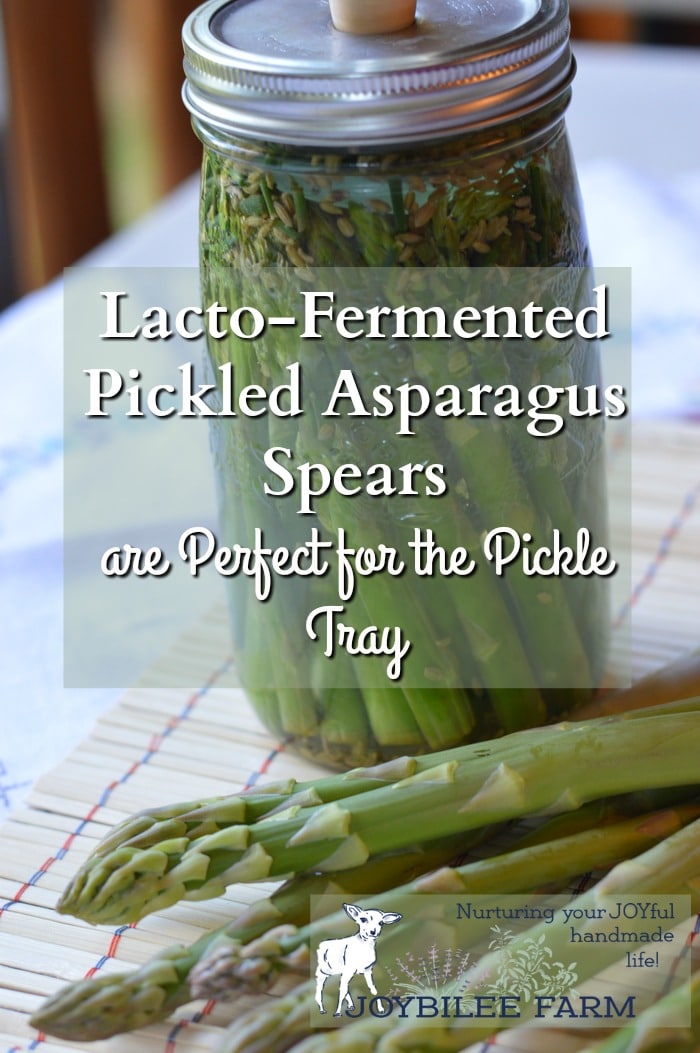
Asparagus is a genteel vegetable. We never ate it at home, growing up. It was out of our budget, always a little pricier than cabbages and carrots. But the ladies at church made these fancy luncheon sandwiches with pickled asparagus, using white bread that was sliced at the bakery along the long edge of the loaf. They cut off the crusts and smeared butter and cream cheese along the bread. Then they rolled the sliced bread around a long, pickled asparagus spear, jelly roll fashion. Then they sliced these rolls into pin-wheels. They were stunning on the fancy sandwich tray. Any asparagus that didn’t make it into the tea sandwiches was used on the pickle tray. These sandwiches were always the first to disappear. But despite its genteel appearance, that fancy asparagus was always pretty soggy, mushy, and limp. It was a disappointment.
This recipe will give you tangy pickled asparagus with a crunch. Crunchy, lacto-fermented asparagus is a better filling for fancy tea sandwiches and a nicer addition to the pickle tray. This is what asparagus was made for.
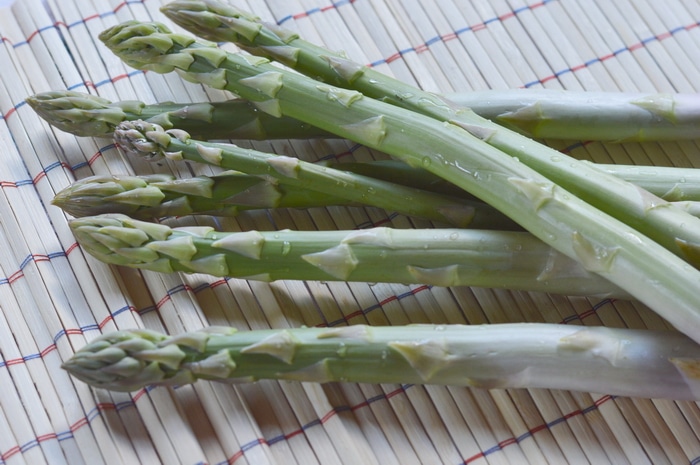
Pickled asparagus with lacto-fermentation
Yield: 1 quart
Ingredients:
1 bunch of asparagus, enough to fill a quart jar
2 tbsp. chives, chopped
1 tbsp. fennel seed
4 cloves of garlic, peeled and halved
2 tablespoons Celtic salt or Himalayan salt
3 cups of filter water
2 tablespoons of starter liquid from a successful vegetable ferment (optional)
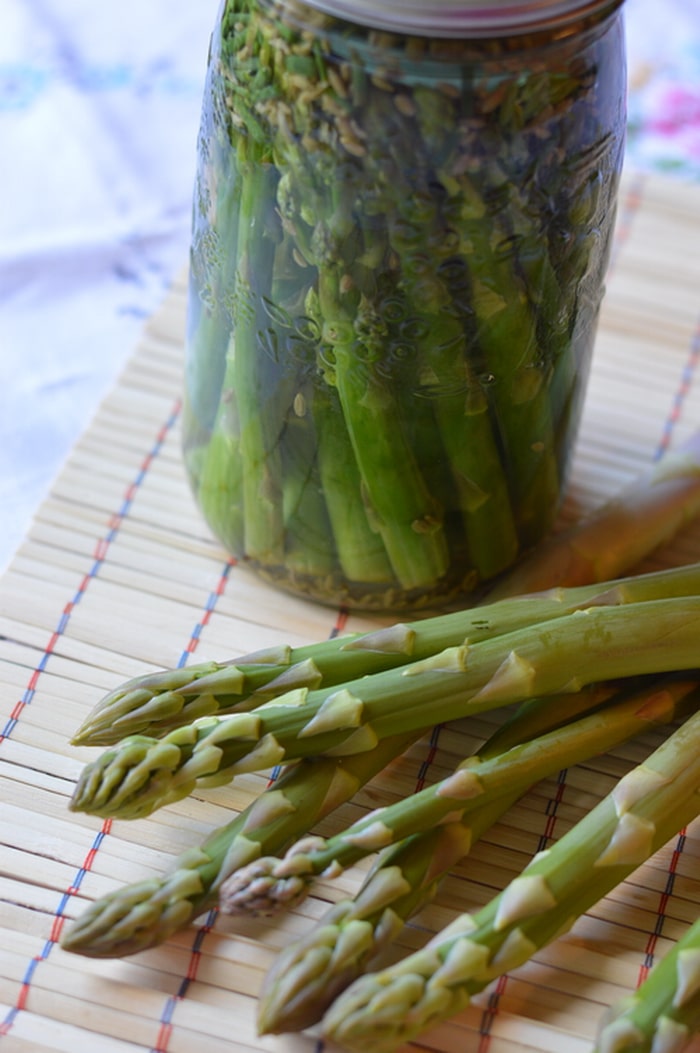
Directions:
Wash the asparagus. Trim the asparagus to 6 inch lengths, removing the tough, fibrous root end. You’ll have extra asparagus leftover from the trimmings for dinner. Discard the root ends or save them to flavour broth. All parts of the asparagus can be used.
Place the asparagus spears so that they are standing upright in the jar. The spears should come below the shoulder of the jar to leave room for the glass weight. If your spears are longer, trim them to fit your jar.
Add the chives, fennel seed, and garlic cloves to the jar, shaking the jar gently to distribute the herbs and spices. Mix the salt with the filtered water. (Don’t use chlorinated tap water for this. The chlorine will inhibit the fermentation.) Pour the brine over the asparagus spears in the jar. Fill to within an inch of the rim of the jar. Add starter if you are using it.
Place a glass weight over the asparagus spears in the jar, pressing it down so that the liquid in the jar comes up over the weight. Place an airlock lid on the jar. Place the jar on a plate to catch any brine overflow.
Place the jar in a cool spot out of direct sunlight. 50°F to 70°F is the ideal range. Allow the jar to ferment for a week or so, until the pressure in the jar slows down and the ferment is no longer bubbling. Remove the weight and the fermentation air lock lid. Replace the lid with a storage lid.
The ferment may be eaten right away or placed in a cool storage area, where the temperature is stable at 45°F to 55°F. The jar may also be refrigerated. The jar will keep in a cool spot for 6 to 12 months. The flavors will become more complex and tangy over time.
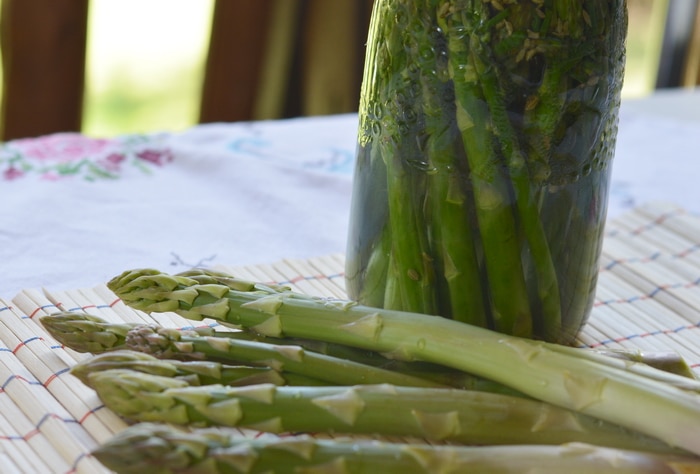
Do you have to refrigerate your lacto-fermented food?
No you don’t. Refrigeration stops the fermentation process and doesn’t allow the complex acidity and flavours to develop fully. Many cultures around the world have kept their vegetables preserved without canning and without refrigeration through lacto-fermentation. When lacto-fermented vegetables are placed in a cold storage room or a root cellar, where the temperature stays between 45 and 55 degrees year round, the lacto-bacteria continues to proliferate in the brine. This prevents spoilage, while increasing the complexity of the flavour.
Can you refrigerate it?
Yes you can. You will stop the lacto-bacteria from continuing to proliferate in the jar. The flavor will stay as it is rather than developing more tangy flavours.
How to use pickled asparagus
Use lacto fermented pickled asparagus:
- On the pickle tray
- In fancy tea sandwiches
- On the crudité tray beside raw vegetables
- Wrapped in bread with smoked salmon spread
- With grilled chicken on a bun
- As a pizza topping with prosciutto
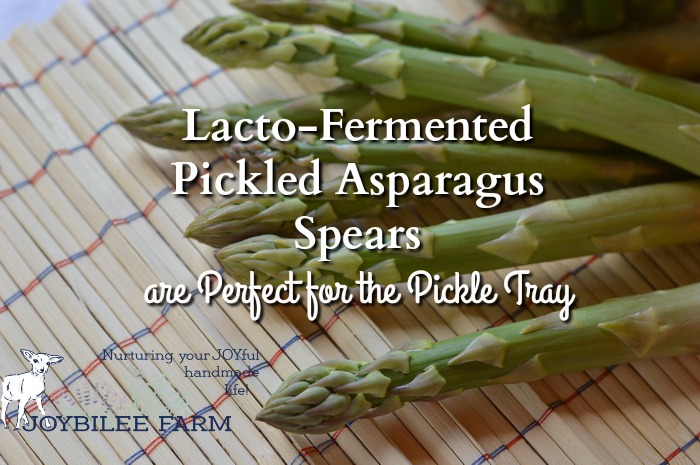
As the asparagus harvest is pouring in, set aside a few pounds of asparagus for lacto-fermented pickled asparagus spears and take advantage of this fancy addition to the lacto-fermented food menu.



I have been a kefir “grower” for about two years, so having whey around is not a problem. I fermented my first batch of eggplant a few weeks ago and it was delicious. Can hardly wait to try my hand at sauerkraut, carrots, Brussel sprouts and other fall favorites.
I have never tried pickled asparagus, but have seen a few recipes on how to make it. I mainly just pickle and eat onions and cucumbers, but I can definitely see myself branching out the next time I go to pickle something. This looks like such a simple and delicious recipe! I can’t wait to try it out at home. Thanks for sharing!